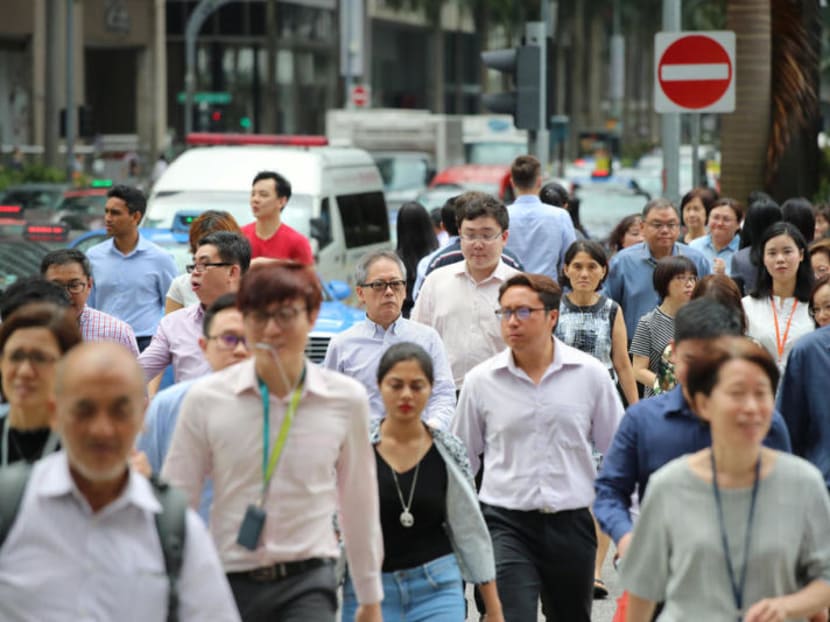Retirement, re-employment ages should be pegged to healthy lifespans, say researchers
SINGAPORE — Rather than enshrining the retirement and re-employment ages of older workers in law, two researchers are calling for an overhaul to how these ages are determined to consider the healthier lifestyles today.

Singaporeans are expected to lead healthy lives until they reach 74.2 years old, but the retirement age has remained at 62 from 1999 to today.
SINGAPORE — Rather than enshrining the retirement and re-employment ages of older workers in law, two researchers are calling for an overhaul to how these ages are determined to consider the healthier lifestyles today.
Instead of the present practice of periodic reviews, researchers Christopher Gee and Damien Huang from the Institute of Policy Studies (IPS) want the retirement and re-employment ages pegged to what is known as the Health-Adjusted Life Expectancy (Hale). That is the average number of years that people are expected to lead healthy lives.
This would allow both age ceilings to rise in tandem with the longer healthy lifespans of successive cohorts, helping workers understand that “there is no fixed age by which people’s productive lives must end”, the researchers said on Monday (Aug 5).
Right now, Singaporeans are expected to lead healthy lives until they reach 74.2 years old, compared with 67.1 in 1990, a difference of more than seven years. Mr Gee said that Singaporeans enjoy the longest healthy life expectancy in the world today, with the upward trend likely to continue.
However, the retirement age has remained at 62 from 1999 to today, which means that the average Singaporean can typically work for another 12.2 years while in full health.
The retirement age prohibits employers from dismissing workers younger than 62 for age reasons, and employers must offer renewable re-employment contracts to workers when they reach 62 with a minimum one-year term.
Singapore’s re-employment age of 67 — the age where employers will no longer need to offer re-employment to workers — is 7.2 years under the Hale benchmark.
Hale is computed from data of diseases and mortality risk by the United States-based Institute of Health Metrics and Evaluation as well as Singapore’s Health Ministry.
The suggestion follows Manpower Minister Josephine Teo’s announcement during this year’s debate into her ministry’s budget that both ages are set to increase.
DE-POLITICISE RETIREMENT
In their report, IPS senior research fellow Gee and research associate Huang said that the current gap between the fixed ages and healthy life expectancy shows that “policy lags” exist, due to the periodic process in which retirement and re-employment ages are determined.
“While regular reviews of these fixed ages can be scheduled, this exposes the review process and the associated tripartite consultation to the vagaries of the economic and political cycles,” the duo wrote.
Asked by TODAY why this is a concern, Mr Gee said: “Why should an important protection for workers against unfair dismissal purely on the grounds of age be dependent on the state of the economy, or the political appetite to make these changes?”
He pointed out that in some countries with state-funded pension schemes, the retirement age can be a “political hot potato”, with implications on taxation and the sustainability of these schemes.
“In Singapore, our retirement and re-employment age legislation is designed to protect workers from unfair dismissal purely on the grounds of their age, and should therefore be less politically contentious and unconnected to the state of the economy. A worker should be protected from unfair discrimination regardless of economic conditions,” he said.
FIGHT AGAINST AGEISM
Besides, fixing these age ceilings also worsens the “ageist mindsets” held by employers and workers. These fixed ages become entrenched as thresholds such that those above the legislated ages are arbitrarily classified as “old” and no longer as productive as they were before.
Part of the reason for this is the legacy of the “old colonial practice of British civil servants retiring at age 55”, giving rise to an anchoring effect in which people fixate on a particular age associated with exiting the workforce, Mr Gee told TODAY.
Therefore, using Hale as a dynamic link to retirement and re-employment ages would “enhance employment protection for cohorts of healthier older Singaporeans to remain in the workforce and counter attitudes that create artificial ceilings for older workers’ ability to remain employed”, Mr Gee and Mr Huang argued.
Noting that countries such as Denmark, Greece, the Netherlands and Portugal have already linked their retirement ages and pension eligibility ages to life expectancy, the duo said that these countries did so to address the problem of longer lifespans, which has put pressure on their pension systems.
They urged the Government to peg the ages to Hale, but with a 10-year lag. For example, in 2029, the re-employment age could use the Hale age this year. Doing so would allow people to enjoy the benefits of improvements to healthy lifestyles, while allowing both employers and employees to prepare for the changes, they added.
The paper also called for the terms “retirement age” and “re-employment age” to be immediately relabelled as the “structured re-employment age” and the “optional re-employment age” respectively. The Retirement and Re-employment Act, too, should also be renamed as the Re-employment Act, the researchers proposed.
Mr Gee and Mr Huang said: “(Through) simple changes to the terminology used in the Retirement and Re-employment Act legislation, deep-seated misconceptions over the intent of the legislation will be minimised, focusing attention on the goal of employment protection for older workers.”
THE CPF QUESTION
The IPS researchers had recently called for the Central Provident Fund (CPF) contribution rates of older workers to be raised to the same level as that of younger workers, to allow them to improve their retirement adequacy.
They emphasised that their paper is not recommending a change at this time to the CPF payout eligibility age — now set at 65 — because it is beyond the scope of the study.
Mr Gee said that the payout eligibility age — which determines the minimum age one can begin to draw lifelong annuity payouts under CPF Life for retirement — was linked to retirement adequacy and total life expectancy.
“But that is a whole different kettle of fish, and what we are trying to do in this policy paper is to suggest steps we can take to separate the issues in peoples’ minds in the right ways, rather than to allow the misconceptions to persist,” he added.








